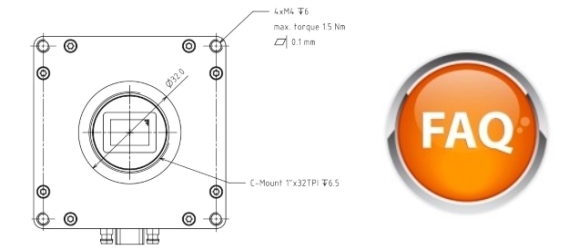CCD with USB 3.0 - xiD camera line¶
FAQ - frequently asked questions¶
Measurement questions¶
Q: What were the conditions under which XIMEA measured/tested the xiD models ?
Temperature of the environment: 24°C
Temperature of the sensor: 35°C
Reading frequency (slow readout/fast readout etc.): 26/52/65MHz
Channels of readout: 1/2/4 TAP readout
Maximum dT between sensor and camera housing: 20°C (uncooled camera)
Total readout noise (photon transfer function):
conversion factor (gain): 0.68
e/ADU (analogue digital units): 0.74
e-/uV: 0.82 e-/ADU
Bias (offset): Compensated in AFE
Total readout noise: 7.2 / 8.8 / 9.7 e- (readout 26/52/65MHz)
Saturation/full well capacity: 20ke typical
Maximum linearity error: <1%
Q: Will the measurement for dark current be added anytime soon?
Dark current is mostly compensated by AFE so it is almost impossible to measure it.
What was measured is ~10^-12 ADU/s
It may be possible to calculate it from saturation level, however, this will contain leak as well.
Just for example: the dark current on MD028 is around 1.2 e/s/pix with 35°C inside the camera.
Q: What is the longest exposure time?
Exposure value depends on the readout mode.
For example, in the beginning, it was 305s on MD028 model.
From API version 4.1.70 the camera models will be able to reach exposition of 713s and longer in 1 TAP mode.
Q: What is the electronic gain range for the camera models?
Electronic gain (not numeric) is:
MD028: 36dB
MD061: 41dB
MD091: 37dB
MD120: 36dB
Settings questions¶
Q: Is there ROI feature restriction?
With CCD sensors, in general, the change of horizontal part of ROI (Region of interest) will not increase the speed.
Vertical ROI will improve speed, but it has also restrictions for the Region of interest, which has to be close to the middle of the frame - vertically centered.
Q: Are the drivers of the xiD the same as for xiQ ?
The driver and API are the same.
However, the feature set may differ from xiQ.
Frame rate questions¶
Q: What is the maximum framerate of MD028 at 640x480, 1024x768, 1600x1200 for 8 bits?
For 4TAP, binning 1x1, 52MHz readout the frame rates are approximately:
1936 x 480 – 159 fps
1936 x 768 – 102fps
1936 x 1200 – 67fps
Q: Is there a difference in the frame rate between 12 and 14 bit image acquisition?
All transfers are done in 16bit so there is no difference between 8bit or 14 bit for example.
Q: Is there a table with the frame rates for all implemented Tap and Binning modes?
Yes, this binning mode is supported and implemented.
Please check the Manual
Q: Can the announced value of 57 fps at full resolution (2.8 Mpix) be increased even higher?
The speed of 57 fps has been measured at 52 MHz.
However, it is possible to overlock and go higher with 65Mhz.
Readout noise is similar for all modes.
The only difference is the number of TAPs.
The frame rate is affected through the number of TAPs, MHz frequency and possible CMS.
CMS = Correlated multiple sampling.
Physical questions¶
Q: Is there a digital input that can be read with each frame and passed back in the form of frame header/metadata?
All IO's are sampled at the beginning of image transfer. Meaning 2 in and 2 out.
Q: Are Sony CCD sensors (2.8, 6.1, 9 and 12 MP) available in taped glass versions?
Unfortunately, Sony sensors are not available with taped glass.
Customers can try to remove it at their own risk.
Q: How to avoid light leakage on the sensor if a LED is used at the rear of the camera?
For long exposure, it's indeed necessary to be sure to have no leaks of light and therefore the sensor is properly shielded from camera LED indication.
However, for longer exposures, it is wise to turn them off.
Q: How is the humidity handled inside the camera and dew on the clear window in front of the sensor?
The cameras have a silica gel chamber to prevent humidity inside the camera and to reduce the dew.
Q: Is there a special USB3 cable needed for the operation of MD091 and MD120 models ?
Indeed, these cameras require more power than cameras with smaller resolution.
In order to deliver the expected current, you should use cables with small resistance (e.g. short or good quality).
Please use our diagnostic application xiCOP to check if your cable has an acceptable resistance.
